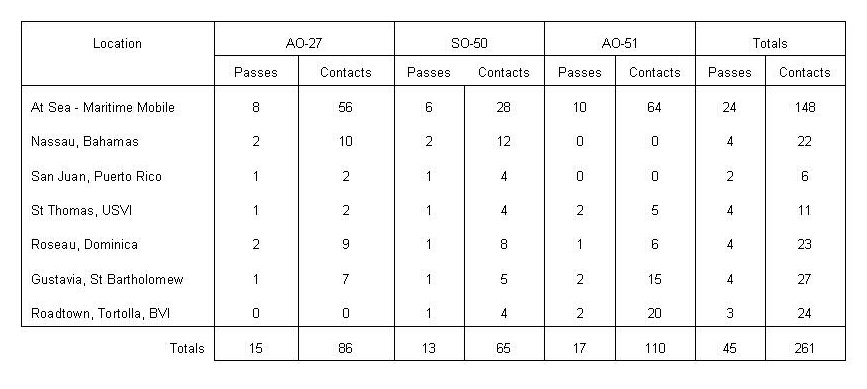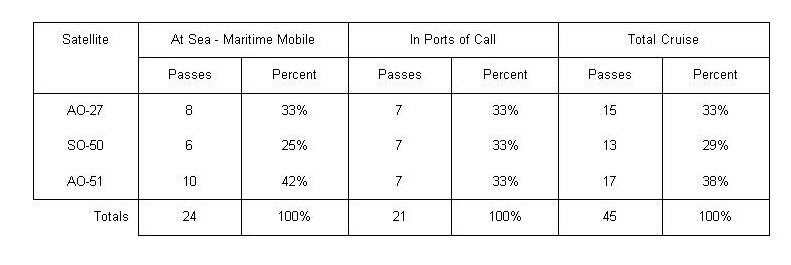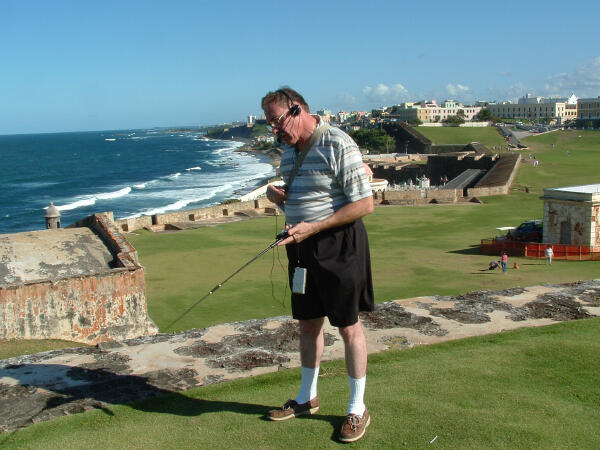Caribbean Cruise
Satellite Operation a Success
Allen F. Mattis, N5AFV,
[email protected]
Introduction
I had the wonderful opportunity to operate the FM LEO
satellites while on a Caribbean cruise December 17-27, 2005. The cruise departed Port Everglades, FL,
and sailed to the island of Dominica in the Lesser Antilles
and back to Port Everglades.
Amateur radio operation was conducted at sea as a maritime mobile, and
at six ports of call.
Previous
experience operating on cruises (Mattis, 2003 and 2005c) helped me prepare for
this cruise and its successful amateur radio satellite operation. All contacts were made on AO-27, SO-50
and AO-51 using an Icom W32A HT and an AL800 telescoping antenna. This equipment has become my preferred
choice when operating on cruises (Mattis, 2005a and 2005b).
Summary Statistics
While
on the cruise, a total of 45 satellites passes were worked, and 261 contacts
were made (Figure 1). Amateur radio
satellite operation was conducted on all three of the active FM LEO satellites
(Figure 2). Contacts were made with
amateur radio stations in 27 US
states, 4 Canadian provinces, 3 Mexican states, and Guadeloupe, Martinique,
Puerto Rico and Venezuela. I also heard a Brazilian station, but
was unable to make a contact with him.
The average number of contacts made per satellite pass was 5.8. Contacts at sea as a maritime mobile
comprised 57% of the total contacts, and 43% of the total contacts were made
while in port. This was the first
cruise where I made an effort to operate from all ports of call.

Figure 1. Summary of satellite passes and
contacts by location, N5AFV cruise December
17-27, 2005

Figure 2. Summary of satellite passes and
contacts by satellite, N5AFV cruise December 17-27, 2005
Discussion
Obtaining
licenses for operation from the various ports of call on a cruise can take a
great deal of time and advance planning (Mattis, 2005c). On this particular cruise, my US license covered operation from Puerto Rico and the US Virgin Islands. I also have a reciprocal license from
the Bahamas,
which was the first port of call and where the ship was flagged. Another port of call was the French island of St Bartholomew, and the CEPT convention
gave me instant operating privileges there. Obtaining licensing for the remaining
two ports of call was more challenging.
The
British Virgin Islands application procedure
for a reciprocal amateur radio license (http://www.qsl.net/oh2mcn/vp2v.htm)
appeared to be easy to follow, and I prepared to submit my application. Copies of both my passport identification
page and my FCC amateur radio license had to be notarized as being true copies,
and an application form had to be filled out. I also submitted an international money
order in the amount of $20.10.
However, because it was in the second half of the year, the correct fee
was $10.10. I was not aware that British Virgin Islands reciprocal amateur radio licenses
are issued for the calendar year and expire on December 31st. This $10 overpayment delayed issue of
the license. I was able to contact
the office of the Telecommunications Manager in the Ministry of Communications
& Works by e-mail and explain that I planned to visit the British
Virgin Islands in a few weeks and needed the license issued before
my cruise sailed. The license
arrived by mail ten days later.
.

Figure3. KP4/N5AFV working KE4AZN on SO-50 from
El Moro, San Juan National Historic Site, Puerto Rico
Obtaining
a reciprocal amateur radio license for Dominica appeared to be straight
forward when I looked at the information on the ARRL website
(http://www.arrl.org/FandES/field/regulations/io/recip-info_a.html#j7). I submitted an application according to
the website instructions, and later sent an e-mail to the licensing authorities
to inquire about the progress of my application. I received a reply by e-mail informing
me that my call sign would J79AFV, and that I should pick up my license at
their office when I arrived in Dominica. I checked satellite pass times for my
stop in Dominica
and realized that there would be a satellite pass before I had time to pick up
my license. I inquired by e-mail
about obtaining permission to operate before picking up my license, and I
received a reply by e-mail that authorized me to operate as J79AFV for one year
beginning November 16, 2005. When I
arrived in Dominica,
I began operating immediately.
Later in the afternoon, I went to the National Telecommunications
Regulatory Commission office to pick up my license. I was informed that my license had been
sent to the customs office at the dock where I landed and that I should pick it
up there. I picked up the license
on my way back to the ship, and it was then I found out that the call sign
issued to me had been changed to J79AFM.
Local amateur radio operators in Dominica usually receive a J73 call
sign with their initials as the suffix, and reciprocal operators usually
receive a J79 call sign with their home call sign suffix. My initials are AFM, and this was done
as a favor to me. The contacts I
made using the call sign J79AFV are valid; I just used an incorrect call sign
while operating those passes. This
incident illustrates some of the complications that can arise with amateur
radio licensing in foreign countries.
When I was as far east as I would get on the cruise, I
worked a number of east passes hoping to make a contact across the Atlantic Ocean.
Even though I was not able to make a trans-Atlantic contact, those
passes did yield some very enjoyable results. On two east passes, I had very nice
conversations with Mark, VO1ONE, in Newfoundland. On another east pass, I enjoyed a
four-way round table with Rony, FG5FU, Julien, FM0HN, and Pedro, YV6PM. These east passes are clear examples of
one of the primary purposes of amateur radio as described in FCC Part 97.1(e):
“Continuation and extension of the amateur's unique ability to enhance
international goodwill.”
Conclusion
Operation on the satellites during this cruise was very
enjoyable. The amateur radio
operators on the satellites were very courteous which allowed a high number of
contacts to be made. I look forward
to operating on another cruise in the future.
References
Mattis, Allen, 2003, Prior planning - key to a successful DX
cruise: The AMSAT Journal,
May/June (Volume 26, No. 3), pp
24-26, (reprinted from Worldradio, 2002, April,
p. 18-21).
Mattis, Allen, 2005a, HT and AL800 Antenna – An
Excellent Portable Satellite Station:
The
AMSAT Journal, March/April (Volume 28, No. 2), p. 21-23.
Mattis, Allen, 2005b, Postscript to HT and AL800 Antenna
– An Excellent Portable Satellite
Station:
The AMSAT Journal, March/April (Volume 28, No. 3), p. 17.
Mattis, Allen, 2005c, Satellites and Cruising – A
Winning Combination, Proceedings of
the
AMSAT-NA 23rd Space Symposium, p 128-138.
Published in The AMSAT Journal,
January/February, 2006, (Vol 29, No.1), pp. 5,7.
Return to Cruise Web Page
E-mail - [email protected]
Created:
February 18, 2006 by Allen F. Mattis
Last Updated: February 18, 2006


